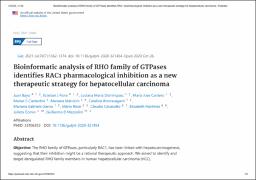| dc.contributor.author | Buyo, Juan. | |
| dc.contributor.author | Fiore, Esteban. | |
| dc.contributor.author | Dominguez, Luciana. | |
| dc.contributor.author | Et al. | |
| dc.date.accessioned | 2023-05-12T14:53:52Z | |
| dc.date.available | 2023-05-12T14:53:52Z | |
| dc.date.issued | 2021-07 | |
| dc.identifier.citation | Gut . 2021 Jul;70(7):1362-1374. | es |
| dc.identifier.issn | 1468-3288 | |
| dc.identifier.uri | https://riu.austral.edu.ar/handle/123456789/2155 | |
| dc.identifier.uri | https://gut.bmj.com/content/70/7/1362.long | |
| dc.description | Disponible en: https://gut.bmj.com/content/70/7/1362.long | es |
| dc.description.abstract | Abstract
Objective: The RHO family of GTPases, particularly RAC1, has been linked with hepatocarcinogenesis, suggesting that their inhibition might be a rational therapeutic approach. We aimed to identify and target deregulated RHO family members in human hepatocellular carcinoma (HCC).
Design: We studied expression deregulation, clinical prognosis and transcription programmes relevant to HCC using public datasets. The therapeutic potential of RAC1 inhibitors in HCC was study in vitro and in vivo. RNA-Seq analysis and their correlation with the three different HCC datasets were used to characterise the underlying mechanism on RAC1 inhibition. The therapeutic effect of RAC1 inhibition on liver fibrosis was evaluated.
Results: Among the RHO family of GTPases we observed that RAC1 is upregulated, correlates with poor patient survival, and is strongly linked with a prooncogenic transcriptional programme. From a panel of novel RAC1 inhibitors studied, 1D-142 was able to induce apoptosis and cell cycle arrest in HCC cells, displaying a stronger effect in highly proliferative cells. Partial rescue of the RAC1-related oncogenic transcriptional programme was obtained on RAC1 inhibition by 1D-142 in HCC. Most importantly, the RAC1 inhibitor 1D-142 strongly reduce tumour growth and intrahepatic metastasis in HCC mice models. Additionally, 1D-142 decreases hepatic stellate cell activation and exerts an anti-fibrotic effect in vivo.
Conclusions: The bioinformatics analysis of the HCC datasets, allows identifying RAC1 as a new therapeutic target for HCC. The targeted inhibition of RAC1 by 1D-142 resulted in a potent antitumoural effect in highly proliferative HCC established in fibrotic livers.
Keywords: cancer genetics; drug development; fibrosis; hepatocellular carcinoma; liver cirrhosis.
© Author(s) (or their employer(s)) 2021. No commercial re-use. See rights and permissions. Published by BMJ. | es |
| dc.language.iso | en | es |
| dc.publisher | BMJ Publishing Group | es |
| dc.rights | Attribution-NonCommercial-NoDerivatives 4.0 Internacional | * |
| dc.rights.uri | http://creativecommons.org/licenses/by-nc-nd/4.0/ | * |
| dc.subject | Cancer genetics. | es |
| dc.subject | Drug development. | es |
| dc.subject | Fibrosis. | es |
| dc.title | Bioinformatic analysis of RHO family of GTPases identifies RAC1 pharmacological inhibition as a new therapeutic strategy for hepatocellular carcinoma | es |
| dc.type | Article | es |


